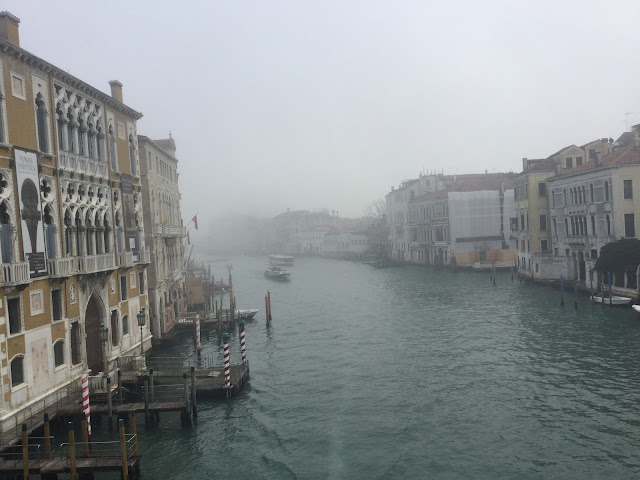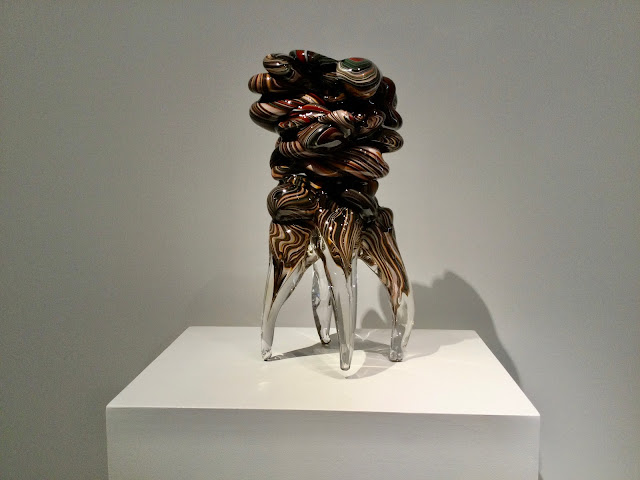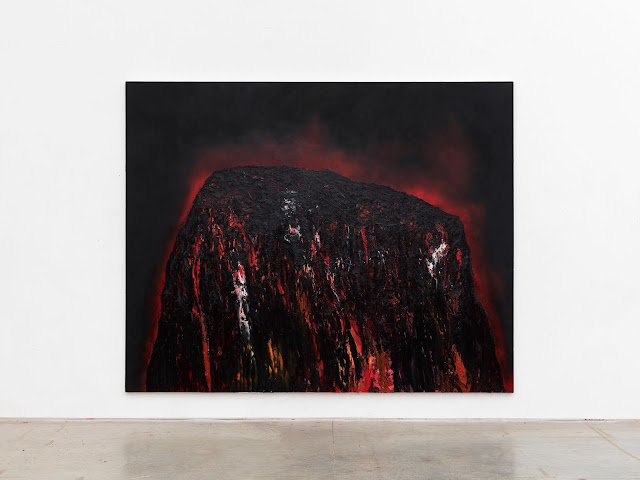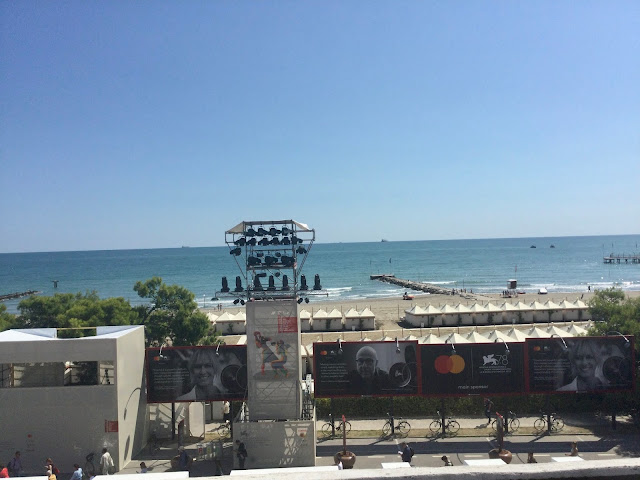 |
Archinto by Georg Baselitz at Palazzo Grimani - Photo: Cat Bauer
|
(Venice, Italy) Georg Baselitz, the renowned German artist who flips life upside down on its head, has two major installations in Venice showing about the same time as the
Biennale International Architecture Exhibition, which opened to the public on May 22 and runs through November 21.
At age 83, Baselitz seems to have been firing on all cylinders during the pandemic, with a slew of new works now showing at both the Vedova Foundation on the Zattare, Vedova accendi la luce (Vedova Turn on the Light) which closes on October 31, 2021, and Archinto at Palazzo Grimani in Castello, which is scheduled to run another year through November 27, 2022, coinciding with the Biennale International Art Exhibition.
 |
Vedova accendi la luce by Georg Baselitz at Maggazino del Sale - Photo: Cat Bauer
|
George Baselitz at Maggazino del Sale
If you hurry, you can catch Georg Baslitz's Vedova accedi la luce in the Magazzino del Sale, the space of the Fondazione Emilio e Annabianca Vedova on the Zattare designed by Renzo Piano. The Venetian artist Emilio Vedova and the German artist Georg Baselitz were great friends, a relationship that began when the two men met in Berlin in the early 1960s.
Even though Vedova died in 2006, it seems that Baselitz still talks to his friend through the ether. He has produced 17 paintings three meters high that are divided into two sequences. Baselitz presents seven works that play with painting "in the manner" of Vedova and 10 paintings that explore the theme of… ice cream.
The title of the exhibition, Vedova, Turn On the Light is taken from the title of one of the works on display, painted by Baselitz in 2020. The range of different flavors of ice cream with titles like Erdbeere (Strawberry) and Vanille (Vanille) are images of the artist's wife, Elke, to whom he has been married for more than 60 years.
Vedova accedi la luce runs through October 31, 2021. Go to the
Vedova Foundation for more information.
 |
Archinto by Georg Baselitz - Photo: Cat Bauer
|
Georg Baselitz at Palazzo Grimani
What a brilliant idea to install Archinto, an exhibition of new and recent paintings and sculptures by Georg Baselitz, inside Palazzo Grimani. The exhibition has top pedigree, curated by Mario Codognato and organized by Venetian Heritage and Direzione Regionale Musei Veneto, in association with Gagosian.
The empty 18th-century stucco-framed panels in the Sala del Portego once held somber portraits of illustrious ancestors. Now Baselitz's bright and colorful upside-down paintings with titles like Archinto All Mixed Up and Archinto Laughing light up the hall, and will remain on long-term loan to the museum from the artist. Never before has a contemporary artist had such an arrangement with a State museum in Venice.
A Brief History of Palazzo Grimani & the Grimani Family
For years, it seemed that nobody knew quite what to do with Palazzo Grimani, which is over on the other side of town from the Zattare, just off Campo Santa Maria Formosa. The palace dates back to the Middle Ages, and began life as a typical Venetian Gothic palazzo.
 |
Portrait of Antonio Grimani attr. Palma il Giovane - Photo: Cat Bauer
|
Antonio Grimani
Sometime in the late 15th century, Palazzo Grimani was acquired by Antonio Grimani
(1434-1523), son of a poor patrician father and mother from the lower classes. Antonio's father died when he was young, and he was raised by
an uncle
Antonio worked his way up in society until he earned his right to trod amongst the aristocracy. He married well to Caterina Loredan, from a distinguished noble family, with whom he would have either four or five sons, depending on the source. He traded in pepper and sailed the Eastern Mediterranean, becoming one of Venice's wealthiest and most controversial merchants.
Antonio had a gift for diplomacy, and dealt with emperors and kings on behalf of Venice. He was nearly 50 when he was appointed to the prestigious post of a Savio di Terraferma, with more important posts to follow. But his greatest love was the sea, and in 1494 at the age of 60 he accepted the appointment as Capitano da Mar, commander-in-chief of the Venetian navy.
In 1499, after two disastrous battles with the Ottoman Turks, Antonio returned to Venice in shackles. He was imprisoned and put on trial. The judges condemned him to death for treason. The sentence was commuted to exile for life, and Antonio was sent to Osor on the island of Cres in Croatia.
In July 1500, Antonio passed Palazzo Grimani onto his sons Vincenzo, Girolamo and Pietro. Another son, Domenico, had become a Cardinal and would play a major role in restoring his father’s reputation.
 |
Portrait of Domenico & Marino Grimani attr. Palma il Giovane - Photo: Cat Bauer
|
Domenico Grimani
Domenico was either the third or eldest son of Antonio and Caterina (depending on the source), and was born in 1463. Destined for the Church from an early age, Domenico was made a Cardinal in 1491. He had inherited his father's gift for diplomacy, and entered the most powerful circles in Rome, coming a breath away from being elected Pope. In 1497 Domenico became Patriarch of Aquileia.
Domenico's position gave the Grimani family hefty weight in
mediating relations between Rome and the Republic of Venice. In addition
to being extremely wealthy, Domenico was a Humanist and a collector,
and assembled one of the most important libraries of the early
Renaissance, along with paintings by the likes of Leonardo da Vinci,
Giorgione, Titian and Bosch, as well as sculptures and other works of
art.
Knowing he had a powerful son who was a Cardinal, in 1502 Antonio fled his banishment in exile and hightailed it to Rome. Somehow Domenico obtained permission to live in the massive Palazzo San Marco that had previously belonged to the Venetian Pope Paul II (1417-1471), which was later renamed Palazzo Venezia and became the seat of the ambassadors of Venice.
The Sculptures
Even though the Grimanis were now living in splendor in Palazzo San Marco, Antonio wanted a more permanent home for the family in Rome. He bought a plot of land and started construction. During excavation work for the foundations, a number of spectacular ancient sculptures were discovered, which Domenico was delighted to display in the rooms of Palazzo San Marco.
These sculptures were the start of the Grimanis' passion for collecting fine antiquities -- and it is these antiquities found 500 years ago in Rome that we can see with our own eyes today in the Domus Grimani exhibition inside Palazzo Grimani in Venice -- some of which date back to before the birth of Christ.
We can only imagine what went on behind the scenes, but Antonio Grimani was back in Venice before the year 1509 had ended and was immediately reinstated in his post of Procurator of Saint Mark. Over the years, his commitment and loyalty to Venice was never again questioned after he showered bountiful good works and performed skillful diplomacy for La Serenissima. On the death of Doge Leonardo Loredan -- who was also the brother of Antonio's wife, Caterina -- on July 6, 1521, Antonio was elected doge at the age of eighty-six. Doge Grimani’s reign lasted less than two years, and he died on May 7, 1523.
Lost in Translation
Over the years, Palazzo Grimani passed to Antonio's surviving sons, and then to his grandsons. Different sources have different histories of the family, with different dates. There is a lot of confusion about who was related to whom and in what way because the Italian word for nephew is nipote, which is also the word for grandson. Some Italians have translated nipote into nephew when writing in English, when it actually should be translated into grandson. In other instances, the word is correctly translated from nipote to nephew, but different relatives have the same first name -- it is utterly confusing, and I wish I had access to genealogy chart.
 |
Portrait of Giovanni Grimani attr. Domenico Tintoretto - Photo: Cat Bauer
|
Giovanni Grimani
With all that in mind, contrary to some sources, the influential Giovanni Grimani (1506-1593), Bishop of Ceneda was not Doge Antonio Grimani's nephew, he was his grandson, the fourth son of Antonio's son, Gerolamo (the Grimanis were a family packed with male heirs).
One of Giovanni's older brothers was Marino Grimani (1488-1546), who, like his Uncle Domenico, the Cardinal, (remember that Domenico was Doge Antonio’s son) was also made a Cardinal in 1528. Cardinal Domenico had been dead about five years by then -- leaving his precious carved gemstones, medals and cameos to his nephew Marino. When Cardinal Marino died in 1546, Pope Paul III took all of Marino's loot by "right of spoil."
Giovanni was appointed Patriarch of Aquileia in 1545 -- a position ALSO formerly held by his powerful Uncle Cardinal Domenico. He paid 3,000 scudi to get back his brother Cardinal Marino’s collections, and the rare objects were returned to Venice in 1551.
Giovanni decided to enlarge Palazzo Grimani, which was completed in 1568. The impressive Sala della Tribuna was created to display the Grimani family's bountiful collection of antiquities, full of pillars and niches in which to place individual precious treasures.
 |
Sala della Tribuna empty - Photo: Venetian Heritage
|
Palazzo Grimani was the family home until 1865. It slowly sank into decay as ownership changed hands throughout the years. The Italian state acquired the building in 1981 in "deplorable condition," and it underwent years of extensive restoration. It finally opened as a public museum in 2008, but there was not much inside except phantoms of the past.
The empty Sala della Tribuna was splendid to see, but void of all the precious antiquities that it had been designed to hold, many of which were stashed in the National Archaeological Museum in Piazza San Marco, run by the Italian State.
Palazzo Grimani Joins the Museums of the Veneto
In 2015, Palazzo Grimani became one of the museums in the Regional Directorate for Veneto Museums, the Polo Museale del Veneto -- which means it came under the control of Daniele Ferrara, who is the Director of that museum complex. The complex is a branch of the Italian Ministry of Culture and consists of 20 museums and institutions throughout the Veneto region (and whose website is still only in Italian in the year 2021).
Enter Toto Bergamo Rossi, director of Venetian Heritage, an international non-profit organization that safeguards the immense legacy of Venetian art and culture in what was once the Republic of Venice (and manages to get English translations for all its projects).
 |
Domus Grimani - Sala della Tribuna in all its glory - Photo: Venetian Heritage
|
Domus Grimani 1594-2019
Together, Toto Bergamo Rossi and Daniele Ferrara curated the astonishing Domus Grimani 1594-2019 exhibition which reassembled the Grimani's collection of classical sculptures in the original setting for the first time in four centuries. It is simply breathtaking to see the sculptures back where they were designed to be.
The Room of the Doge
Very different from the Tribuna, the Room of the Doge dedicated to Doge Grimani is an airy chamber with walls decorated with garlands of flowers and panels of colored marble. Armed with an inventory from the State Archives drawn up on October 5, 1593 — just two days after the death of Giovanni Grimani — curators Daniele Ferrara and Toto Bergamo Rosi were able to relocate 20 sculptures inside the room by using the the list of precious items, including the imperial Roman era Dionysus leaning on a satyr in the niche of the front wall.
 |
Archinto by Georg Baselitz in Palazzo Grimani - Photo: Cat Bauer
|
Georg Baselitz Archinto
Toss Georg Baselitz's colorful paintings into the mix with Mario Codognato as the curator and you get an ancient palace filled with precious antiquities and contemporary art at the same time. The title "Archinto" refers to Titian's enigmatic 1558 portrait of a partially veiled Cardinal Filippo Archinto. Baselitz created 12 paintings specifically to be displayed in the Sala del Portego of Palazzo Grimani. Seen through the lens of Baselitz's colorful imagination, Titian's Old Master sensibility travels through space and time and emerges as spectral paintings in the stucco frames that once contained the grim portraits of the Grimani family.
Right now all the exhibitions are scheduled to run through November 27, 2022, but I will not be surprised if that deadline is extended for a long, long time. Go to Palazzo Grimani for more information if you can read Italian.
In English, Venetian Heritage has detailed information about each exhibition and more about the great work they do to to increase awareness of the immense legacy of Venetian art in Italy and other parts of what was once the Republic of Venice.
Ciao from Venezia,
Cat Bauer










































